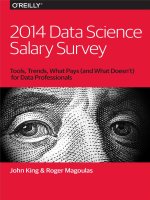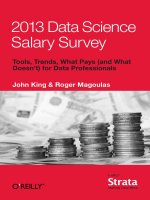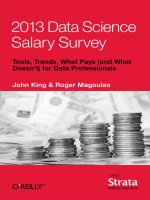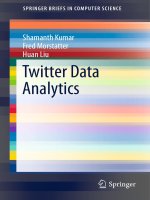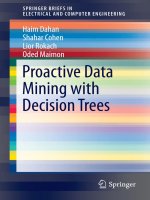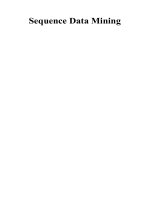IT training 2015 data science salary survey khotailieu
Bạn đang xem bản rút gọn của tài liệu. Xem và tải ngay bản đầy đủ của tài liệu tại đây (4.75 MB, 49 trang )
2015 DATA SCIENCE SALARY SURVEY
2015 Data Science Salary Survey
Tools, Trends, What Pays (and What Doesn’t) for Data Professionals
John King & Roger Magoulas
1
2015 DATA SCIENCE SALARY SURVEY
Take the Data Science
Salary and Tools Survey
As data analysts and engineers—as professionals who
like nothing better than petabytes of rich data—we
find ourselves in a strange spot: We know very little
about ourselves. But that’s changing. This salary and
tools survey is the third in an annual series. To keep
the insights flowing, we need one thing: PEOPLE LIKE
YOU TO TAKE THE SURVEY.
Anonymous and secure, the survey will continue to
provide insight into the demographics, work environments, tools, and compensation of practitioners in
our field. We hope you’ll consider it a civic service. We
hope you’ll participate today.
2015 DATA SCIENCE SALARY SURVEY
Make Data Work
strataconf.com
Presented by O’Reilly and Cloudera, Strata + Hadoop
World is where cutting-edge data science and new
business fundamentals intersect—and merge.
■
■
■
II
Learn business applications of data technologies
Develop new skills through trainings and
in-depth tutorials
Connect with an international community
of thousands who work with data
D0849
2015 Data Science
Salary Survey
Tools, Trends, What Pays (and What Doesn’t)
for Data Professionals
John King & Roger Magoulas
2015 DATA SCIENCE SALARY SURVEY
by John King and Roger Magoulas
corporate/institutional sales department: 800-998-9938
or .
The authors gratefully acknowledge the contribution of Owen S.
Robbins and Benchmark Research Technologies, Inc., who conducted the original 2012/2013 Data Science Salary Survey referenced in
the article.
November 15, 2013: First Edition
Editor: Shannon Cutt
Designer: Ellie Volckhausen
Production Manager: Dan Fauxsmith
REVISION HISTORY FOR THE THIRD EDITION
Copyright © 2015 O’Reilly Media, Inc. All rights reserved.
Printed in the United States of America.
Published by O’Reilly Media, Inc., 1005 Gravenstein Highway North,
Sebastopol, CA 95472.
O’Reilly books may be purchased for educational, business, or sales
promotional use. Online editions are also available for most titles
(). For more information, contact our
November 13, 2014: Second Edition
September 2, 2015: Third Edition
2015-09-02: First Release
While the publisher and the author(s) have used good faith efforts to
ensure that the information and instructions contained in this work
are accurate, the publisher and the author(s) disclaim all responsibility
for errors or omissions, including without limitation responsibility for
damages resulting from the use of or reliance on this work. Use of the
information and instructions contained in this work is at your own risk.
If any code samples or other technology this work contains or describes
is subject to open source licenses or the intellectual property rights of
others, it is your responsibility to ensure that your use thereof complies
with such licenses and/or rights.
2015 DATA SCIENCE SALARY SURVEY
Table of Contents
2014 Data Science Salary Survey....................................................1
Executive Summary...........................................................................1
Introduction.....................................................................................2
How You Spend Your Time..............................................................13
Tools versus Tools ...........................................................................21
Tools and Salary: A More Complete Model.......................................30
Integrating Job Titles into Our Final Model........................................33
Finding a New Position....................................................................38
Wrapping Up..................................................................................39
V
2015 DATA SCIENCE SALARY SURVEY
OVER 600
RESPONDENTS
FROM A VARIETY
OF INDUSTRIES
COMPLETED
THE SURVEY
VI
THE RESEARCH IS BASED ON DATA collected through an
online 32-question survey, including demographic information,
time spent on various data-related tasks, and the use/non-use
of 116 software tools.
2015 DATA SCIENCE SALARY SURVEY
Executive Summary
NOW IN ITS THIRD EDITION, the 2015 version of the Data
Science Salary Survey explores patterns in tools, tasks, and
compensation through the lens of clustering and linear models. The research is based on data collected through an online
32-question survey, including demographic information, time
spent on various data-related tasks, and the use/non-use
of 116 software tools. Over 600 respondents from a variety
of industries completed the survey, two-thirds of whom are
based in the United States.
Key findings include:
• The same four tools—SQL, Excel, R, and Python—remain
at the top for the third year in a row
• Spark (and Scala) use has grown tremendously from last
year, and their users tend to earn more
• Using last year’s data for comparison, R is now used by
more data professionals who otherwise tend to use commercial tools
• Inversely, R is no longer used as frequently by data practitioners who use other open source tools such as Python
or Spark
• Salaries in the software industry are highest
• Even when all other variables are held equal, women are
paid thousands less than their male counterparts
• Cloud computing (still) pays
• About 40% of variation in respondents’ salaries can be
attributed to other pieces of data they provided
We invite you to not only read the report but participate: try
plugging your own information into one of the linear models
to predict your own salary. And, of course, the survey is open
for the 2016 report. Spend just 5 to 10 minutes and take the
anonymous salary survey here: />ds-salary-survey-2016. Thank you!
1
2015 DATA SCIENCE SALARY SURVEY
Introduction
FOR THE THIRD YEAR RUNNING, we at O’Reilly
Media have collected survey data from data scientists,
engineers, and others in the data space about their
skills, tools, and salary. Some of the same patterns we
saw last year are still present—newer, scalable open
source tools in general correlate with higher salaries,
Spark in particular continues to establish itself as a
top tool. Much of this is apparent from other sources:
large software companies that traditionally produced
only proprietary software have begun to embrace open
source; Spark courses, training programs, and conference talks have sprung up in great numbers. But who
actually uses which tools (and are the old ones really
disappearing)? Which tools do the highest earners use,
and is it fair to attribute a particular variation in salary
to using a certain tool? We hope that the findings in
this iteration of the Data Science Salary Survey will go
beyond what is already obvious to any data scientist or
Strata attendee.
2
Preliminaries
This report is based on an online survey open from November
2014 to July 2015, publicized to the O’Reilly audience but open
to anyone who had the link. Of the 820 respondents who
answered at least one question, about a quarter dropped out
before completing the survey and have been excluded from
all segments of analysis except for those showing responses to
single questions. We should be careful when making conclusions
about survey data from a self-selecting sample—it is a major
assumption to claim it is an unbiased representation of all data
scientists and engineers—but with a little knowledge about our
audience, the information in this report should be sufficiently
qualified to be useful. As is clear from the survey results, the
O’Reilly audience tends to use more newer, open source tools,
and underrepresents non-tech industries such as insurance and
energy. O’Reilly content—in books, online, and at conferences—
is focused on technology, in particular new technology, so it
makes sense that our audience would tend to be early adopters
of some of the newer tools.
2015 DATA SCIENCE SALARY SURVEY
A final word on the self-selecting nature of the sample: differences
between results in this survey and other surveys may simply arise
from the samples’ idiosyncrasies and not from any meaningful difference. Findings from other salary survey reports—there have been a
few recently in the data space—sometimes conflict directly with our
findings, but this doesn’t necessarily imply that one set of findings
are erroneous. Likewise, discrepancies between our own salary
surveys don’t necessarily imply a trend. The methodology between
this year’s survey and last year’s is close enough to allow us to make
some conclusions based on year-to-year differences, but only when
the numbers are very strong.
Introducing the Sample: Basic
Demographics
Before we discuss salary we should describe who exactly took the
survey. Despite the fact that this is a “data science” survey, only
one-quarter of the respondents have job titles that explicitly identify
them as “data scientists.” Of course, it is debatable how much
meaning can be assumed simply from a job title—more on that
later—but it’s safe to say that the data science world is inhabited by
people who call themselves something else: by job title, 14% of the
sample are analysts, 10% are engineers (usually “data,” “software,”
or “analytics” engineers), 6% are programmers/developers, 3%
are architects (of various kinds), 4% are in the business intelligence
sector, and 1% are statisticians. Management is also present in the
sample: managers (9%) and directors (5%) are the most significant
groups, with a handful of VPs, CxOs, and founders as well. The rest
of the sample comprised mostly of students, postdocs, professors,
and consultants. Judging by the tools used by the sample, the vast
majority—even the managers—had some technical side to their
role, regardless of job title.
Beyond job title, the sample includes respondents from 47 countries
and 38 states across multiple industries, including software, banking,
retail, healthcare, publishing, and education. Two-thirds of the survey
sample is based in the US, and compared to its share in population,
California is disproportionately represented (22% of the US respondents, 15% of the total sample). The software industry’s 23%
share is the largest among industries, and this excludes other “tech”
industries such as IT consulting, computers/hardware, cloud services,
search, and (computer) security; when considered in aggregate,
these account for 40% of the sample. A third of the sample is from
companies with over 2,500 employees, while 29% comes from
companies with fewer than 100 employees. One-third of the sample
is age 30 or younger, while less than 10% is older than 45.
In terms of education, 23% of the sample hold a doctorate
degree, and 44% (not including the PhDs) hold a master’s. Many
respondents reported to be a “student, full- or part-time, any
level”: aside from the 3% who gave job titles indicating full-time
study (usually at the graduate level), 15% of the sample—data
scientists, analysts, and engineers—said they were students.
Two-thirds of respondents had academic backgrounds in computer science, mathematics, statistics, or physics.
3
WORLD REGION
SHARE OF RESPONDENTS
4%
6%
CANADA
UK/IRELAND
67%
12%
EUROPE (EXCEPT UK/I)
5%
UNITED STATES
ASIA
1%
AFRICA
(ALL FROM
SOUTH AFRICA)
3%
LATIN AMERICA
2%
AUSTRALIA/NZ
SALARY MEDIAN AND IQR* (US DOLLARS)
United States
Europe (except UK/I)
Region
UK/Ireland
Asia
Canada
Latin America
Australia/NZ
Africa (all from South Africa)
0K
50K
100K
150K
Range/Median
*The interquartile range (IQR ) is the middle 50% of respondents' salaries. One quarter of respondents have a salary below this range, one quarter have a salary above this range.
US REGION
SHARE OF RESPONDENTS
10%
17%
PACIFIC NW
NORTHEAST
11%
15%
22%
MID-ATLANTIC
MIDWEST
CALIFORNIA
9%
10%
SW/MOUNTAIN
SOUTH
5%
TEXAS
SALARY MEDIAN AND IQR (US DOLLARS)
California
Northeast
Region
Midwest
Mid-Atlantic
Pacific NW
South
SW/Mountain
Texas
0
50K
100K
Range/Median
150K
200K
2015 DATA SCIENCE SALARY SURVEY
Salary: The Big Picture
The median annual base salary of the survey sample is $91,000,
and among US respondents is $104,000. These figures show no
significant change from last year.1 The middle 50% of US respondents earn between $77,000 and $135,000. For understanding
how salary varies over features we introduce a linear model; for
now we only consider basic demographic variables, but later we
will introduce others that describe respondents’ work and skills
in more detail. While looking at median salaries for a particular
slice of respondents gives a general idea of how much a certain
demographic might influence salary, a linear model is a simple way
of isolating and estimating the “effect” of a certain variable.2
Management
Because the directors, VPs and CxOs, and founders, in this
order, come from companies of decreasing size, their actual
hierarchal level is more or less even (and, it turns out, so are
their salaries), and we group them together when constructing salary models. We call this group “upper management”
to distinguish them from regular “managers” (who include
project and product managers), although it should be remembered that few, if any, respondents come from large companies
above the director level. For the basic model we will ignore job
title distinctions except for the two management categories. That
is, the first model treats data “scientists” and data “analysts”
6
the same. However, we exclude those respondents who
are students.3
A basic, parsimonious linear model
We created a basic, parsimonious linear model using the lasso
with R2 of 0.382.4 Most features were excluded from the model
as insignificant:
70577 intercept
+1467 age (per year above 18; e.g., 28 is +14,670)
–8026 gender=Female
+6536 industry=Software (incl. security, cloud services)
–15196 industry=Education
-3468 company size: <500
+401 company size: 2500+
–15196 industry=Education
+32003 upper management (director, VP, CxO)
+7427 PhD
+15608 California
+12089 Northeast US
–924 Canada
–20989 Latin America
–23292 Europe (except UK/I)
–25517 Asia
BASE SALARY
Share of Respondents
0K
20K
40K
60K
80K
100K
120K
140K
160K
180K
200K
220K
240K
<240K
0
5%
10%
Base Salary
(US DOLLARS)
15%
20%
2015 DATA SCIENCE SALARY SURVEY
Gender
Just as in the 2014 survey results, the model points to a
huge discrepancy of earnings by gender, with women
earning $8,026 less than men in the same locations at
the same types of companies. Its magnitude is lower than
last year’s coefficient of $13,000, although this may be
attributed to the differences in the models (the lasso has
a dampening effect on variables to prevent over-fitting),
so it is hard to say whether this is any real improvement.
Geography
In terms of geography, the top-earning locations are California
(+$16,000) and the Northeast (+$12,000; from NY/NJ into
Education
According to this model, a PhD is worth $7,500 (each
year) to a data scientist. As for a master’s degree—its
estimated contribution to salary was not significant
enough for the algorithm to make it into this first model.
GENDER
SHARE OF RESPONDENTS
Female
Male
0
20
40
60
SALARY MEDIAN AND IQR (US DOLLARS)
Female
Male
30K
60K
90K
Range/Median
8
80
Gender
Starting at a base salary of $70,577, we add $1,467 for
every year of age past 18 (so the base for a 48-year-old is
$114,587). Salaries at larger companies tend to be higher—add another $401 if your company has more than
3,000 employees, but subtract $3,468 if it has fewer than
5005—and the software industry is the only one to have
a significant positive coefficient. Education has a negative
coefficient—presumably, these are largely respondents
who work at a university. Those in upper management take
home an average of $32,000 extra in their base salary.
New England), while the rest of the country, as well as UK/Ireland and Australia/NZ, are estimated to be roughly equal. The
rest of Europe, meanwhile, is much lower (–$23,000), not far
off from Asia (–$26,000) and Latin America (also –$21,000).
Making reliable distinctions in salary between countries, as
opposed to the continental aggregates, is not possible due to
the relatively small non-US sample.
Gender
Base pay
120K
150K
AGE
6%
14%
36 - 40
46 - 50
13%
5%
51 - 55
41 - 45
3%
56 - 60
25%
1%
31 - 35
61 - 65
SALARY MEDIAN AND IQR (US DOLLARS)
>1%
under 21
23%
26 - 30
OVER 65
21 - 25
26 - 30
31 - 35
9%
21 - 25
1%
UNDER 21
SHARE OF RESPONDENTS
Age
36 - 40
41 - 45
46 - 50
51 - 55
56 - 60
61 - 65
over 65
0
50K
100K
Range/Median
150K
200K
INDUSTRY
SHARE OF RESPONDENTS
5%
EDUCATION
6%
5%
5%
CONSULTING
(NON-IT)
GOVERNMENT
4%
PUBLISHING / MEDIA
ADVERTISING /
MARKETING / PR
7%
HEALTHCARE / MEDICAL
3%
8%
COMPUTERS /
HARDWARE
RETAIL / E-COMMERCE
3%
1%
10%
MANUFACTURING
(NON-IT)
SECURITY (COMPUTER / SOFTWARE)
BANKING / FINANCE
1%
2%
SEARCH / SOCIAL NETWORKING
10%
CONSULTING (IT)
CARRIERS /
TELECOMMUNICATIONS
1%
CLOUD SERVICES / HOSTING / CDN
23%
SOFTWARE
(INCL. SAAS,
WEB, MOBILE)
2%
INSURANCE
2%
NONPROFIT /
TRADE ASSOCIATION
SALARY MEDIAN AND IQR (US DOLLARS)
Software (incl. SaaS, Web, Mobile)
Consulting (IT)
Banking / Finance
Retail / E-Commerce
Healthcare / Medical
Publishing / Media
Industry
Education
Consulting (non-IT)
Government
Advertising / Marketing / PR
Computers / Hardware
Manufacturing (non-IT)
Carriers / Telecommunications
Nonprofit / Trade Association
Insurance
Cloud Services / Hosting / CDN
Search / Social Networking
Security (computer / software)
0
30K
60K
90K
Range/Median
120K
150K
COMPANY SIZE
12%
6%
10%
2,501 - 10,000
EMPLOYEES
1,001 - 2,500
EMPLOYEES
22%
10,000+
EMPLOYEES
501 - 1
EMPLOYEES
2%
NOT APPLICABLE
20%
101 - 500
EMPLOYEES
17%
26 - 100
EMPLOYEES
SALARY MEDIAN AND IQR (US DOLLARS)
1
2-25
Company Size
26 - 100
101 - 500
11%
2-25 EMPLOYEES
501 - 1,000
1,001 - 2,500
2,501 - 10,000
1%
1 EMPLOYEE
SHARE OF RESPONDENTS
10,000 or more
0
50K
100K
Range/Median
150K
200K
2015 DATA SCIENCE SALARY SURVEY
How You Spend Your Time
ANOTHER SET OF QUESTIONS on the survey asked for
the approximate amount of hours spent on certain tasks,
such as data cleansing, ETL, and machine learning. For
managers, directors, VPs, and executives (even at small
companies), the task breakdown is very different, as we
would expect: fewer technical tasks, more meetings.
Removing their responses gives us a general idea of how
people spend their time in the data space.
up the most hours: 39% spend at least one hour per day
cleaning data.
Even among non-managers, it appears that the more time
spent in meetings, the more a data scientist (/analyst/engineer) earns. About half of the respondents report spending
at least one hour per day on average in a meeting, with
12% spending at least four hours per day in meetings. This
pattern is confirmed when we add the task features to the
salary model.
A final variable will be introduced for the second salary
model: bargaining skills. While not exactly an objective rubric, the one-to-five scale (“poor” to “excellent”) is a simple way of estimating an incontrovertibly valuable skill. The
distribution of answers was symmetric, with 40% choosing
the middling “3” and 8% each choosing the extreme values of “1” and “5.”
Among technical tasks, basic exploratory analysis occupies more time than any other, with 46% of the sample
spending one to three hours per day on this task and 12%
spending four hours or more. After this, data cleaning eats
To put these hour figures into context, it may help to know
the length of the entire work week. Most (75%) of respondents work between 40 and 50 hours per week, with the
remaining 25% split evenly between those who work fewer
than 40 and more that 50 hours per week. Working longer
hours does, in fact, correspond to higher salary.
A Revised Model, Including Tasks
With the new features on top of the ones used previously, we
create a new model. This time, however, we restrict the pool of
13
TASK COUNTS
Percentages are taken from non-managers
(i.e., mostly data scientists, analysts, engineers, programmers, architects)
TIME SPENT ON ETL
SHARE OF RESPONDENTS
43%
32%
1 - 4 HRS / WEEK
20%
1 - 3 HRS / DAY
SALARY MEDIAN AND IQR (US DOLLARS)
less than 1 hour / week
1 - 4 hrs / week
Time Spent
LESS THAN 1 HOUR / WEEK
1 - 3 hrs / day
4+ hrs / day
30K
60K
5%
90K
120K
150K
120K
150K
Range/Median
4+ HRS / DAY
TIME SPENT ON DATA CLEANING
SHARE OF RESPONDENTS
LESS THAN 1 HOUR / WEEK
42%
1 - 4 HRS / WEEK
31%
1 - 3 HRS / DAY
7%
4+ HRS / DAY
SALARY MEDIAN AND IQR (US DOLLARS)
less than 1 hour / week
1 - 4 hrs / week
Time Spent
19%
1 - 3 hrs / day
4+ hrs / day
30K
60K
90K
Range/Median
TASK COUNTS
Percentages are taken from non-managers
(i.e., mostly data scientists, analysts, engineers, programmers, architects)
2015 DATA SCIENCE SALARY SURVEY
TIME SPENT ON BASIC EXPLORATORY DATA ANALYSIS
SHARE OF RESPONDENTS
11%
LESS THAN 1 HOUR / WEEK
SALARY MEDIAN AND IQR (US DOLLARS)
32%
Time Spent
less than 1 hour / week
1 - 4 HRS / WEEK
1 - 4 hrs / week
46%
1 - 3 hrs / day
4+ hrs / day
1 - 3 HRS / DAY
30K
12%
60K
90K
120K
150K
120K
150K
Range/Median
4+ HRS / DAY
TIME SPENT ON MACHINE LEARNING, STATISTICS
SHARE OF RESPONDENTS
34%
29%
1 - 4 HRS / WEEK
27%
1 - 3 HRS / DAY
10%
4+ HRS / DAY
SALARY MEDIAN AND IQR (US DOLLARS)
less than 1 hour / week
1 - 4 hrs / week
Time Spent
LESS THAN 1 HOUR / WEEK
1 - 3 hrs / day
4+ hrs / day
30K
60K
90K
Range/Median
2015 DATA SCIENCE SALARY SURVEY
respondents further: not only do we take out (full-time) students,
but professors, managers, and upper management as well. This
second model has an R2 of 0.408:
14595 intercept
+1449 age (per year of age above 18)
-27823 Asia
+9416 Meetings: 1 - 3 hours / day
+11282 Meetings: 4+ hours / day
+4652 Basic exploratory data analysis: 1 - 4 hours
/ week
+7205 bargaining skills (times 1 for “poor” skills
to 5 for “excellent” skills)
-6609 Basic exploratory data analysis: 4+ hours / day
+663 work_week (times # hours in week, e.g., 40
hours = $26,520)
-2241 Creating visualizations: 4+ hours / day
-1273 Creating visualizations: 1 - 3 hours / day
+130 Data cleaning: 1 - 4 hours / week
-4207 gender=Female
+6593 industry=Software (incl. security, cloud services)
-7696 industry=Education
+1787 company size: 2500+
+13429 PhD
+3496 master’s degree (but no PhD)
+2991 academic specialty in computer science
+17264 California
+9511 Northeast US
+1752 Southern US
-1623 Canada
-3073 UK/Ireland
-20139 Europe (except UK/I)
-24026 Latin America
16
+1733 Machine learning, statistics: 1 - 3 hours / day
Geography
As we reduce the sample under consideration and add
new features, some of the old features change or even
drop out, as is the case with “company size < 500”.
Changes are apparent in the geographic variables: the
penalty for Europe is reduced, coefficients for UK / Ireland
and the Southern US appear, and the California boost
grows even more, to $17,000.
The intercept has been transformed to $14,595, but this is
because we now add $663 per hour in our work week and
$7,205 per bargaining skill “point” (1 to 5). So with a 40hour work week and middling bargaining skills (i.e., a “3”),
a 38-year-old man from the US Midwest would begin the
calculation of base salary at $91,710.
LENGTH OF WORK WEEK
4%
3%
60+ HOURS/WEEK
56 - 60 HOURS/WEEK
6%
51 - 55 HOURS/WEEK
16%
46 - 50 HOURS/WEEK
28%
41 - 45 HOURS/WEEK
SALARY MEDIAN AND IQR (US DOLLARS)
> 30 hours
30 - 35
40 HOURS HOURS/WEEK
36 - 39
Length of Work Week
31%
40 hours
41 - 45
8%
36 - 39 HOURS/WEEK
2%
30 - 35 HOURS/WEEK
2%
> 30 HOURS/WEEK
SHARE OF RESPONDENTS
46 - 50
51 - 55
56 - 60
60+ hours
0K
50K
100K
Range/Median
150K
200K
TASK COUNTS
Percentages are taken from non-managers
Share
of Respondents
2015
DATA
SCIENCE
programmers, architects)
engineers, SURVEY
analysts,SALARY
scientists,
data
mostly
(i.e.,
TIME SPENT ON CREATING VISUALIZATIONS
SHARE OF RESPONDENTS
23%
LESS THAN 1 HOUR / WEEK
SALARY MEDIAN AND IQR (US DOLLARS)
41%
29%
1 - 3 HRS / DAY
Time Spent
less than 1 hour / week
1 - 4 hrs / week
1 - 4 HRS / WEEK
1 - 3 hrs / day
4+ hrs / day
30K
7%
60K
90K
120K
150K
120K
150K
Range/Median
4+ HRS / DAY
TIME SPENT ON PRESENTING ANALYSIS
SHARE OF RESPONDENTS
27%
47%
1 - 4 HRS / WEEK
20%
1 - 3 HRS / DAY
6%
4+ HRS / DAY
SALARY MEDIAN AND IQR (US DOLLARS)
less than 1 hour / week
1 - 4 hrs / week
Time Spent
LESS THAN 1 HOUR / WEEK
1 - 3 hrs / day
4+ hrs / day
30K
60K
90K
Range/Median


